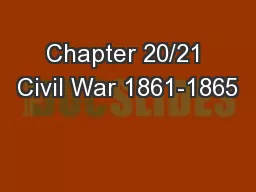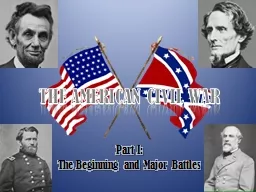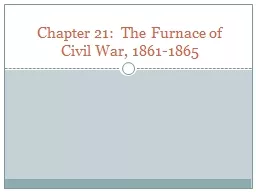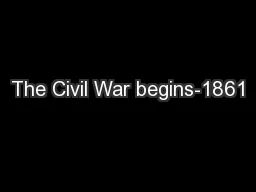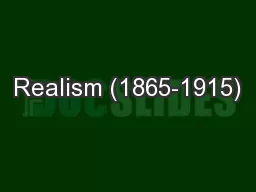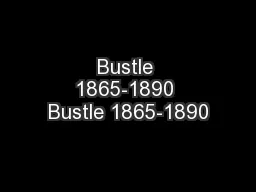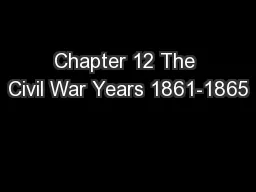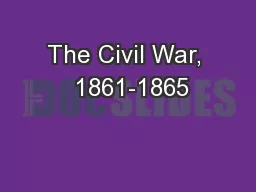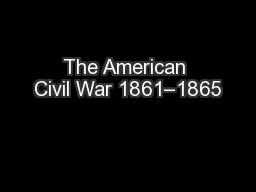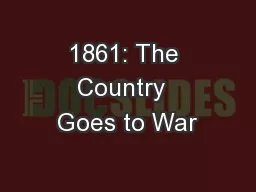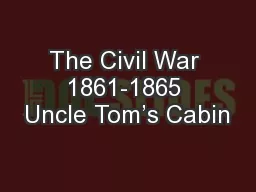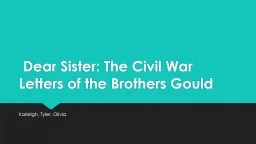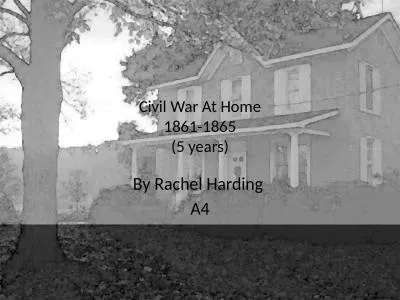PPT-Chapter 20/21 Civil War 1861-1865
Author : stefany-barnette | Published Date : 2018-10-25
Lincoln as President December 1860 March 1861 Buchanans Worries lack of reaction March 1861 Lincoln is sworn into office secretly Lincolns main agenda throughout
Presentation Embed Code
Download Presentation
Download Presentation The PPT/PDF document "Chapter 20/21 Civil War 1861-1865" is the property of its rightful owner. Permission is granted to download and print the materials on this website for personal, non-commercial use only, and to display it on your personal computer provided you do not modify the materials and that you retain all copyright notices contained in the materials. By downloading content from our website, you accept the terms of this agreement.
Chapter 20/21 Civil War 1861-1865: Transcript
Lincoln as President December 1860 March 1861 Buchanans Worries lack of reaction March 1861 Lincoln is sworn into office secretly Lincolns main agenda throughout the Civil War BRING THE UNION BACK TOGETHER preservation. By: Jake Ewing. ETE 100 – 02. November 2, 2009. Abraham Lincoln. 16. th. President of the United States.. President during the Civil War.. Freed the slaves.. President from March 1961- April 1865.. Part I:. The Beginning and Major Battles. The beginning…. THE AMERICAN CIVIL WAR, PART I. THE AMERICAN CIVIL WAR, PART I. Secession. With the election of Abraham Lincoln in November 1860, Southern states started to secede . JUMBO QUESTIONS 21. Periodization. The authors characterize the Battle of Antietam as the “pivotal point” in the Civil War. Many other historians have formulated arguments for additional military or political turning points in the Civil War. What event would you select for the turning point in the Civil War? . Secession and Fort Sumter. Review. Who was U.S. president during most of the Civil War?. What advantages did the North have over the South at the outset of the Civil War?. What was the primary cash crop in the South when the southern . English III. Historical Context. United States grew rapidly after the Civil War. increasing rates of democracy and literacy. rapid growth in industrialism and urbanization. expanding population base due to immigration. Reconstruction (USA). Post war- Expanding businesses, roads, schools, hospitals, etc. Mass production. Immigrants provided workers and new consumers for the clothing industry. Westward expansion. Gold. While slavery is viewed as the main cause of the war, different lifestyles and attitudes also played a part.. Southerners believed that Northerners were bad mannered and greedy. Northerners thought Southerners were backwards and unsophisticated.. Chapter 14. Communities Mobilize for War. The two nations that existed in 1861, the US and the Confederate States of America, were surprisingly . similar. Fort Sumter . -Charleston. , SC . The . fort was low on supplies so Lincoln, hesitantly, ordered non-military supplies be sent to them. Causes. Slavery . Sectional Differences. Lifestyle. Culture. Economic Life. N-Finance & Manufacture . S- Crops & Agriculture . North vs. South . NORTH. Potential . fighting and work force (20-25 million citizens)---immigrants contributed greatly. Secession. Union. Confederacy. Emancipation Proclamation. Gettysburg Address. People. Abraham Lincoln. Jefferson Davis. Robert E. Lee. Ulysses Grant. 1860. 1861. 1863. 1865. 1863. EVENTS LEADING UP TO CIVIL WAR. 1860 Election. Library of Congress. 1860 Election. http://faculty.umf.maine.edu/walter.sargent/public.www/web 232/sumter page.html. 1860 Election. Red. – Lincoln. Yellow. – Bell. Blue. – Douglas. 1852. Harriet Beecher Stowe. Stowe hoped for a quick, peaceful end to slavery. Instead it divided Northerners and Southerners even more. Can you think of another example we have seen that proves sometimes, “the pen is mightier than the sword”?. Karleigh, Tyler, Olivia . About the Author?. The . author is Charles W. . Gould.. Six out of seven . of his brothers . followed . him into Federal service, thus adding to that chronology of events. The Brothers Gould left their families and farms in central New York to go South with their regiments. (5 years). By Rachel Harding . A4. 1861. Even . before the war there was a lot . of . tension between the North and the South because the South wanted to leave the U.S. because Abraham Lincoln was elected president and .
Download Document
Here is the link to download the presentation.
"Chapter 20/21 Civil War 1861-1865"The content belongs to its owner. You may download and print it for personal use, without modification, and keep all copyright notices. By downloading, you agree to these terms.
Related Documents

